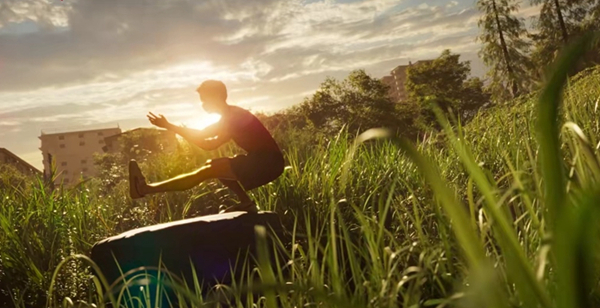
 0 Comment(s)
0 Comment(s) Print
Print E-mail China.org.cn, December 15, 2024
E-mail China.org.cn, December 15, 2024
In China's fast-paced city of Shanghai, where glass skyscrapers tower over ancient alleys, an unexpected hero steps into the limelight. A Juan, a young man both confused and hopeful about the future, finds himself facing formidable opponents and grappling with daunting personal turmoil in the heart of the sprawling metropolis. The animated film "I Am What I Am 2," directed by Sun Haipeng and executive produced by Zhang Miao, charts a poignant journey of self-discovery, with martial arts at its core.

A still from "I Am What I Am 2." [Photo courtesy of Beijing Splendid Culture & Entertainment]
The film follows A Juan as he travels to the city from his hometown in the countryside, driven by a need to earn money for his father's medical treatment. His quest leads him to undertake arduous training and enter the Shanghai Fight Night kickboxing competition, where the stakes and significance extend far beyond mere victory.
Director Sun Haipeng, known for his evocative storytelling, explained that while the first installment focused on lion dancing, its martial arts roots were always integral to the story. "Lion dancing and martial arts are inseparably linked," Sun told China.org.cn. "For the sequel, we wanted to explore this connection more deeply, bringing martial arts into the limelight."
"I Am What I Am 2" hits Chinese theaters on Dec. 14. The previous installment received widespread acclaim and a high score of 8.3/10 on review site Douban, earning 249 million yuan at the box office. Many critics named it the "best animated feature" of 2021 for its unique, realistic approach to storytelling.
Although Shanghai was initially chosen for A Juan's journey as it was beyond his familiar surroundings, it became apparent that the city’s landscape offered a dynamic blend of tradition and modernity, perfectly framing the narrative. "Shanghai has a strong martial tradition, despite its modern veneer. Historically, it has had a strong connection to martial arts, demonstrated by its association with figures like kung fu master Huo Yuanjia," the director explained.
Animating the story was no small feat. Sun and his team conducted extensive research to capture the essence of each location portrayed in the film. "We organized multiple research trips throughout the seasons to accurately convey Shanghai's unique atmosphere," Sun revealed. To this end, textures and local details were meticulously recorded on each visit, ensuring a realistic on-screen portrayal that resonates with both domestic and international audiences.

Director Sun Haipeng (left) and executive producer Zhang Miao speak with audience members at an advance screening of "I Am What I Am 2" in Foshan, Guangdong province, Dec. 7, 2024. [Photo courtesy of Beijing Splendid Culture & Entertainment]
This meticulous approach extended to the action sequences, where a deep understanding of martial arts forms was essential. The film's depiction goes beyond physical prowess; it embodies the philosophy and traditional evolution behind the art. "How can the fundamentals of martial arts be applied to lion dancing? Most lion dance masters are skilled in martial arts, which have evolved from combat to their current forms," Sun said. "To understand their function today, we consulted real masters from different kung fu schools, like Shaolin and Baji Quan. Only after extensive discussions and interactions did we feel confident enough to showcase Chinese martial arts on the big screen, ensuring that we could authentically capture the essence of Chinese kung fu."
The production itself was ambitious, requiring advanced technology and a large team of animators. "The scale of animation is staggering, with rendering needs surpassing the first installment by four times," Sun said. Creating authentic human movements, particularly for bare-chested fighters, demanded a cutting-edge muscle simulation system to ensure realism.
Sun further explains his choice of animation for a realistic story, "Animation allows us to depict the full intensity of physical combat without the constraints of live-action filming." This approach creates vivid, impactful scenes that appeal to viewers.

A poster for "I Am What I Am 2." [Image courtesy of Beijing Splendid Culture & Entertainment]
While the film honors martial arts traditions, it also critiques injustices in life, portraying themes of personal struggle, perseverance and self-worth. "An important aspect of martial arts is about the inner spirit, to keep that breath and faith of life within you alive, no matter your circumstances," Sun said.
Go to Forum >>0 Comment(s)